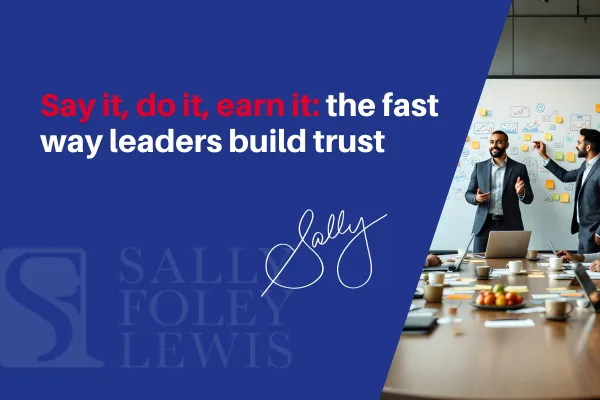
Say it, do it, earn it: the fast way leaders build trust
In late 2009, Domino’s faced a brutal truth. Taste tests and customer feedback said the pizza was poor, “tasted like cardboard”, and the brand had leaned too hard on speed at the expense of quality. So the company went public with its flaws, promised a new recipe, showed the work in its kitchens, and invited customers to judge. Within months, the turnaround was visible. Early 2010 brought a sales surge and improved profits as the new recipe landed with consumers, documented by industry press at the time and later recognised with creative awards for the radical transparency of the “Pizza Turnaround” campaign (1 & 2).
This situation with Domino’s demonstrates the core rule of trust that applies to every middle manager: when words and actions line up in public, credibility compounds quickly. The campaign was not just clever advertising. It was a visible Say-Do alignment: admit the problem, change the product, show the evidence, then let people test the promise. Harvard Business Review later chronicled how this integrity and execution fed a long run of performance improvements (3).
The research behind “say it, do it”
Scholars call this alignment behavioural integrity, defined as the perceived match between a leader’s words and deeds. Tony Simons’ foundational paper in Organization Science explains why promise keeping and congruent values are the bedrock of leader credibility (4).
Trust in leaders is not soft stuff. A meta-analysis by Dirks and Ferrin covering more than 100 studies links trust in leadership to stronger job performance, organisational citizenship, and commitment (5).
Wider sentiment data shows why your local leadership integrity matters. Edelman’s 2024 Trust Barometer reports that trust is fragile and uneven, yet people still look to business and especially “my employer” as comparatively trusted anchors (6).
To help teams operationalise trust, use the Say–Do Velocity Matrix.

Random Acts of Goodness: Low Reliability of Actions and Low Clarity of Words = effort without a narrative
Noise: Low CLarity and High Reliability = confusion and delays
Hollow Slogans: High Clarity and High Reliability = cynicism rises quickly
Integrity Zone: High Clarity and High Reliability = trust compounds fast
This has been adapted from the Say:Do Raion (7)
How middle managers turn integrity into momentum
Here is a five-step routine you can run this week.
Inventory promises. List every open commitment with owner and date. Put it where the team can see it. This turns implicit expectations into explicit contracts, a key idea in behavioural integrity research
Right-size scope before you break it. Renegotiate unrealistic deadlines in the open. It is better to reset early than explain a miss later. FranklinCovey’s practical guide to high-trust behaviours reinforces “Clarify expectations” and “Keep commitments” as daily disciplines (8)
Time-box updates. Even if a task is not finished, report on the agreed date. Silence kills trust; timely updates sustain it.
Score the Say:Do. Publish the weekly ratio for yourself and the team. Celebrate green streaks. For amber or red, fix the root cause together. The ratio should guide learning, not punishment.
Debrief misses in public. When there is a gap, name it, own it, and show exactly how you will close it. That was Domino’s playbook: publicly acknowledge, make the change tangible, and invite judgment.
The burger you can actually bite
If you like a metaphor with your management, picture a burger that matches the menu description every single time. That is trust.

Risks of the opposite
There is a price for getting this wrong. Persistent Say–Do gaps drive cynicism, slow decisions, and create hidden “friction costs”. Meta-analytic evidence shows that when trust is low, performance and citizenship behaviours suffer, which is the opposite of what most managers are trying to achieve (9). A public climate of distrust and you know the stakes and risks rise further.
Bringing it home
You do not need a TV campaign to earn trust. Start with a visible list of promises, a routine for status updates, and a weekly Say:Do scoreboard. State what will change, show the change as it happens, and invite your stakeholders to test the result. In other words, be the leader whose burger always arrives as described. People will taste the integrity and come back for more.